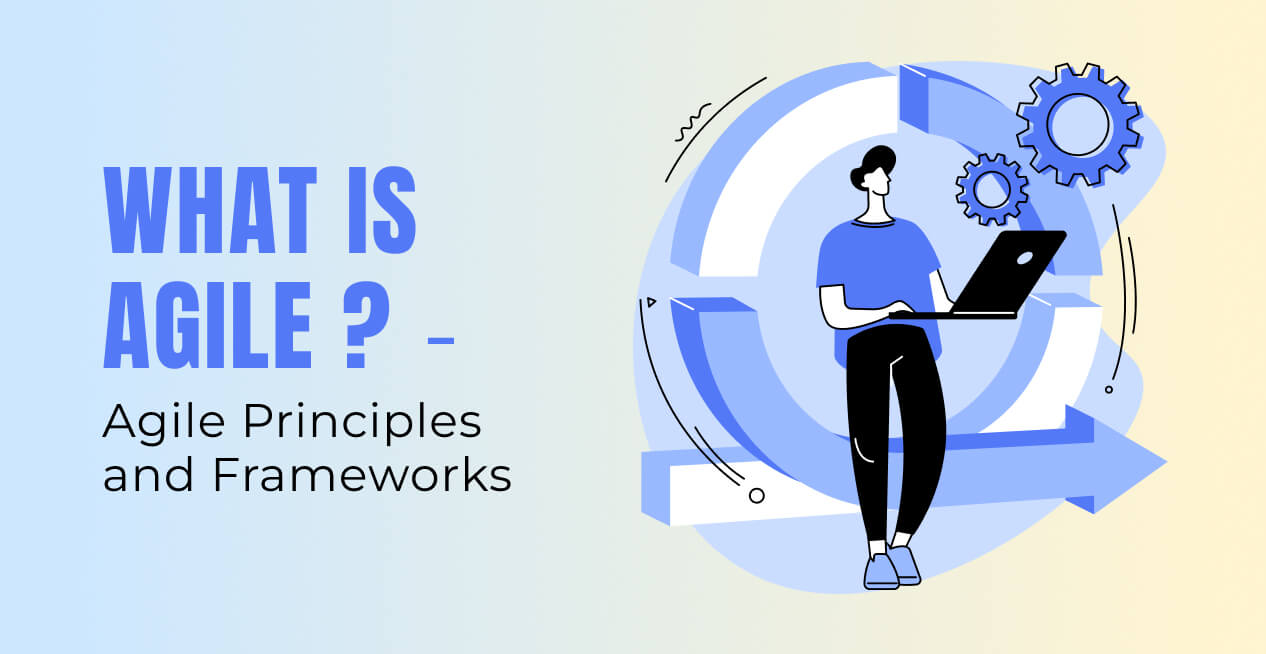Ask any software developer and they will tell you how important it is to be extremely organized when developing software from scratch. From bringing on the client, and knowing their requirements, to materializing that into a successful product is a rollercoaster ride. There are many approaches/frameworks in the market that are deemed most feasible to develop a software product but Agile is the most prevalent and preferred one in the market right now.
Driven by the principles of providing value and collaborating with stakeholders, the agile methodology originates with customers defining the end uses of the final product and the kind of problems the final product attempts to address. This exercise helps in resolving and clarifying the customer’s anticipations and requirements for the project development team.
What is Agile Methodology?
Agile methodology is an iterative approach to software development. This means that the software can be released in iterations or short fragments. This unique feature of agile is known to improve project turnaround time, shorten the lead time between fixes, minimizing failures of releases, and reducing unwanted obstruction to the developmental process. The team members working in an agile environment also get the freedom to micromanage small parts of the software and rectify and catch defects early on while improving quality periodically. This, in turn, increases the efficiency of team members and regulates the quality of the product.
12 Agile Principles as mentioned in Agile Manifesto
Up till the late 1990’s traditional /waterfall approach was used to manage software development projects. Waterfall approach was a linear approach which meant that developmental tasks were taken care of one after another. This particular approach lacked the flexibility to make changes at the later stages and relied heavily on concrete documentation and stringent guidelines for software development.
In 2001, a group of 17 software engineers met in Utah to discuss the increasing need for an alternative to documentation-driven and heavyweight software development processes. They came up with a vision and principles for new-age software development frameworks which is now called the Agile Manifesto. Following were the 12 principles laid down to ensure agile was incorporated in the best way to benefit the company, the client, and the intended audience.
1. Our highest priority is to satisfy the customer through the early and continuous delivery of valuable software.
2. Welcome changing requirements, even late in development. Agile processes harness change for the customer’s competitive advantage.
3. Deliver working software frequently, from a couple of weeks to a couple of months, with a preference to the shorter timescale.
4. Business people and developers must work together daily throughout the project.
5. Build projects around motivated individuals. Give them the environment and support they need, and trust them to get the job done.
6. The most efficient and effective method of conveying information to and within a development team is face-to-face conversation.
7. Working software is the primary measure of progress.
8. Agile processes promote sustainable development. The sponsors, developers, and users should be able to maintain a constant pace indefinitely.
9. Continuous attention to technical excellence and good design enhances agility.
10. Simplicity–the art of maximizing the amount of work not done–is essential.
11. The best architectures, requirements, and designs emerge from self-organizing teams.
12. At regular intervals, the team reflects on how to become more effective, then tunes and adjusts its behavior accordingly.
Ever since then, the Agile framework has become the next best approach for development processes. Based on different requirements many such agile frameworks have emerged, which not only followed these principles but also delivered on the promises of agile software development. Thus, agile is no longer a single framework, rather has become a parent method to many efficient project development methodologies used today. Amongst them, the most popular agile methodologies are Scrum, Kanban, Crystal, Dynamic Systems Development Method (DSDM), Lean, Extreme Programming, and much more! Let us have a look at the top 3 Agile frameworks.
Top 3 Agile Development Frameworks
1. Scrum
Scrum framework has been proven to be one of the most effective agile methodologies. Given its high success rate, not just IT but industries like education, military, marketing, and automotive are now implementing scrum frameworks in their organizational structure and work processes. Scrum is a light framework that helps teams and organizations create value through adaptive solutions for complex problems.
The term ‘scrum’ was first coined in a 1986 Harvard Business Review article by authors Hirotaka Takeuchi and Ikujiro Nonaka. They drew an analogy comparing the high-performing, cross-functional teams of the agile framework to the scrum formation used by rugby teams, and the name stuck. The Scrum method was soon recognized as a highly effective algorithm to perform tasks.
Scrum framework includes many sprint planning sessions wherein the tasks necessary to complete items on the agenda are broken down into small, more easily manageable operations. The team then creates a sprint backlog and plans its implementation. An accredited scrum master guides his team through different processes to get the best result.
2. Extreme Programming or XP
XP framework is a type of developmental framework, also built upon the values and principles of agile. Its primary goal is to allow small to mid-sized teams to innovate on high-quality software and adapt to evolving and changing market and client requirements. However, XP is slightly different with its area of focus compared to other agile methodologies. Instead of focusing on clients or processes, it makes sure that the technical aspects of developing are the best. It stresses the importance of sound technical knowledge of the teams and lays great emphasis on efficient software engineering practices.
Extreme Programming has four major roles among its team members which are customers, programmers, coaches, and trackers. Each of the roles is well-defined and distributed according to team size. XP is also compatible with other methods given its versatile nature. Adopting XP with agile can be extensive but worth it. It ensures that value is delivered at a steady pace and code can accommodate changes even at a later stage because it has followed strict software practices.
3. Kanban
Kanban is yet another crowd favorite when it comes to implementing agile development in work processes. Kanban demands real-time communication and client interaction and full transparency of work. Work items are usually represented visually with the help of kanban boards, allowing team members access to the state of every piece of work at any given time. Kanban boards are basically a process development tool designed to help visualize product teams in designing and see the progress in real-time. Toyota, the popular car manufacturer also uses Kanban methods at the center of its developmental approach and follows 6 important rules for the effective application of Kanban:
- Remove defective products early on;
- Work on a need basis;
- Produce the exact quantity required;
- Level the production;
- Scrutinize and facilitate production;
- Stabilize and rationalize the process.
These rules can be termed as kanban principles and are being adopted by companies all over the world.
Crystal, lean, and DSDM are a few other agile methodologies that are gaining momentum worldwide for their reliability, velocity, and productive outputs in less time. Agile methodologies are extremely versatile which is why different industries are implementing them across various channels and team sizes.
Conclusion
The Agile Methodology completed 22 years of successful project management, this February. It is now hailed as the holy grail of process management for its organizational capabilities, quick turnaround time, easy workflow, and happy clients and stakeholders. All agile methodologies have improved the success rates of organizations by leaps and bounds. One can truly believe that the future is agile.









